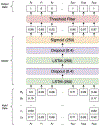MMS SITL Ground Loop: Automating the Burst Data Selection Process
- PMID: 34712702
- PMCID: PMC8549770
- DOI: 10.3389/fspas.2020.00054
MMS SITL Ground Loop: Automating the Burst Data Selection Process
Abstract
Global-scale energy flow throughout Earth's magnetosphere is catalyzed by processes that occur at Earth's magnetopause (MP). Magnetic reconnection is one process responsible for solar wind entry into and global convection within the magnetosphere, and the MP location, orientation, and motion have an impact on the dynamics. Statistical studies that focus on these and other MP phenomena and characteristics inherently require MP identification in their event search criteria, a task that can be automated using machine learning so that more man hours can be spent on research and analysis. We introduce a Long-Short Term Memory (LSTM) Recurrent Neural Network model to detect MP crossings and assist studies of energy transfer into the magnetosphere. As its first application, the LSTM has been implemented into the operational data stream of the Magnetospheric Multiscale (MMS) mission. MMS focuses on the electron diffusion region of reconnection, where electron dynamics break magnetic field lines and plasma is energized. MMS employs automated burst triggers onboard the spacecraft and a Scientist-in-the-Loop (SITL) on the ground to select intervals likely to contain diffusion regions. Only low-resolution survey data is available to the SITL, which is insufficient to resolve electron dynamics. A strategy for the SITL, then, is to select all MP crossings. Of all 219 SITL selections classified as MP crossings during the first five months of model operations, the model predicted 166 (76%) of them, and of all 360 model predictions, 257 (71%) were selected by the SITL. Most predictions that were not classified as MP crossings by the SITL were still MP-like, in that the intervals contained mixed magnetosheath and magnetospheric plasmas. The LSTM model and its predictions are public to ease the burden of arduous event searches involving the MP, including those for EDRs. For MMS, this helps free up mission operation costs by consolidating manual classification processes into automated routines.
Keywords: burst data management; ground loop; long-short term memory (LSTM); magnetopause; magnetospheric multiscale (MMS); mission operations; scientist in the loop (SITL).
Conflict of interest statement
Conflict of Interest: The authors declare that the research was conducted in the absence of any commercial or financial relationships that could be construed as a potential conflict of interest.
Figures








References
-
- Argall MR, Small CR, and Petrik M (2020b). PyMMS: A Python Library for NASA’s Magnetospheric Multiscale (MMS) Mission.
-
- Aunai N, Hesse M, and Kuznetsova M (2013). Electron nongyrotropy in the context of collisionless magnetic reconnection. Phys. Plasmas 20, 1–6. doi: 10.1063/1.4820953 - DOI
Grants and funding
LinkOut - more resources
Full Text Sources
Research Materials
